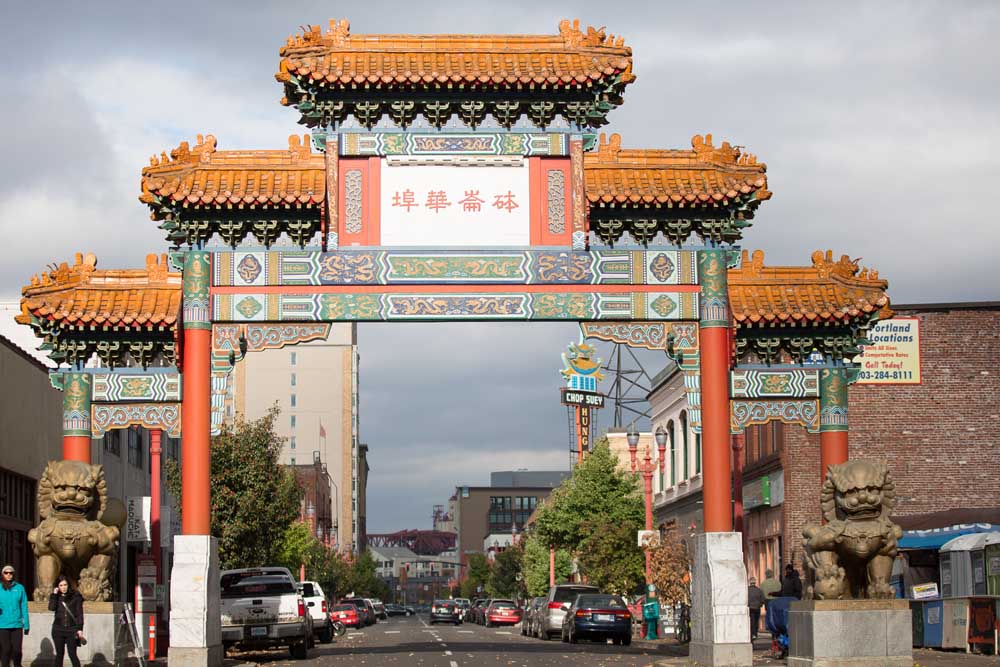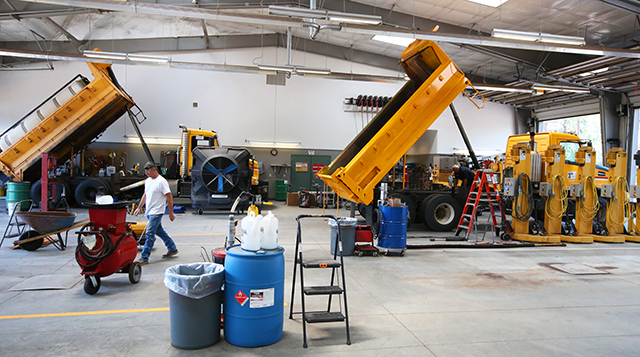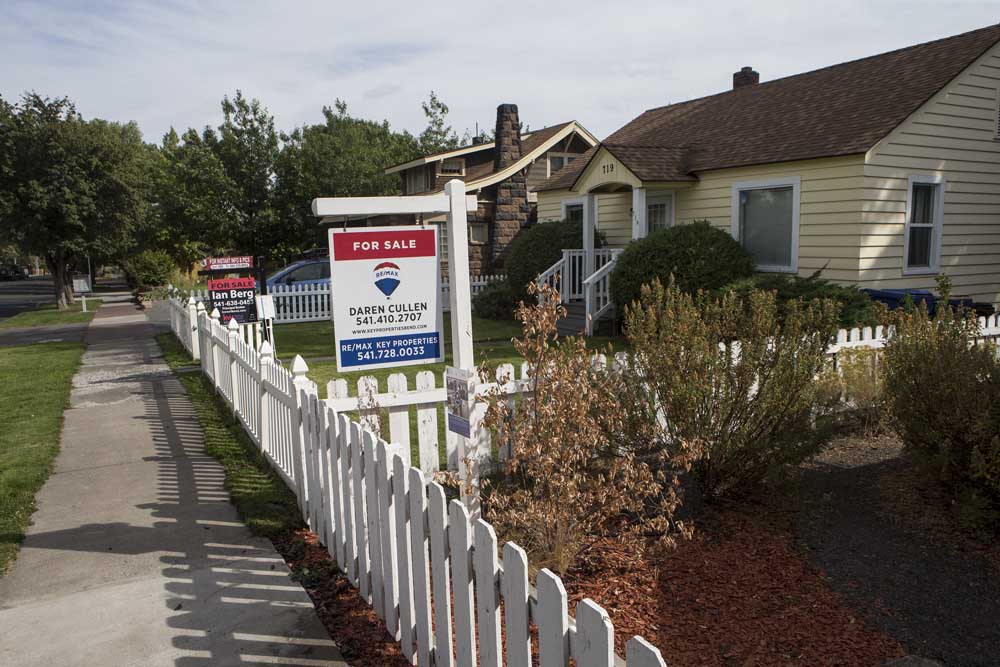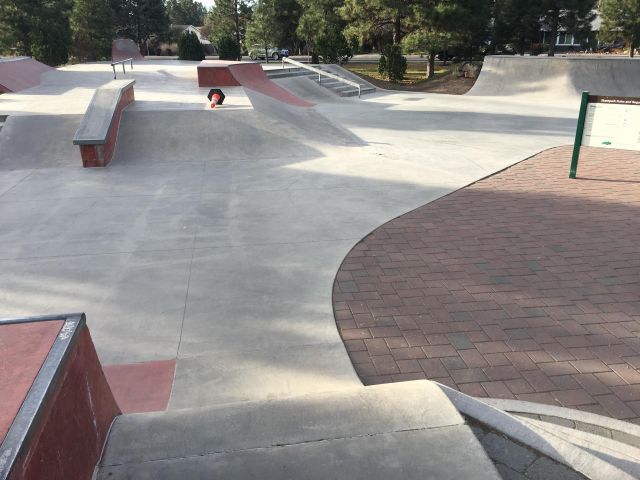New hotel heralds change in Portland’s Old Town/Chinatown
Published 12:00 am Sunday, November 15, 2015

- Photos by Barb Gonzalez / For The BulletinChinatown Gate, dedicated in 1986 and guarded on both sides by imposing bronze lions, stands across North West Third Avenue at Burnside Street. Chinese characters on the north side of the 38-foot-tall monument, built in Taiwan, read “Four Seas, One Family.”
PORTLAND —
As another November morning dawns in Portland’s Old Town/Chinatown neighborhood, the homeless community curls deeper into their blankets and sleeping bags. The sun has arrived too early: In the building alcoves and tree wells that provide modest shelter from the chilly autumn breeze, the poverty-stricken ignore the advent of a new day for as long as possible.
Trending
Beside Chinatown Gate, however, there is hope. Right 2 Dream Too has established a tented community to provide a haven for the homeless. Here is safe sleeping space along with warm coffee, conversation and temporary job opportunities, without the stench of urine that too often punctuates street life. One educated but down-on-his-luck man insists that he is already hard at work on his book, “A Vagrant’s Guide to Portland.”
Around the corner at Floyd’s Coffee Shop, two women, one disheveled, the other well dressed, sit in an upholstered booth beneath an artist’s imaginative portrait of musician Jim Morrison. Their seats are discreet, the conversation less so, as other patrons find their morning brews accented by stories of abandonment, alcoholism and sexual abuse.
Regardless of where life has left one, it’s good to have friends to talk to. Homeless and parentless young people are fortunate that “p:ear” –— an acronym for “project: education, art and recreation” — has a spacious home at Sixth Avenue and Flanders Street. As the morning sun climbs higher, a team of mentors work with dozens of men and women in their late teens and early 20s, assisting with arts, crafts, job skills and self-esteem. One young woman in the barista training program delightedly announces that she has just been hired to work for Starbucks.
Not all activity is at street level. One Pacific Square, a sleek new office building, rises 13 stories above the Willamette River and Burnside Bridge at the edge of this neighborhood. At its foot is the spectacular Lan Su Chinese Garden, an oasis of tranquility in a sea of confusion. Some 300 species of plants and 500 tons of rock surround its central Lake Zither, which is due for a two-month restoration beginning Nov. 23. On this particular morning, activity is bustling. More than two dozen floral designers display their work in anticipation of the impending garden closure.
Grand opening
By noon on Nov. 5, The Society Hotel was a beehive of activity. The young general manager, Zach Miller, clad in jacket, tie and blue jeans, might have been at home with a conductor’s wand as he prepared for the evening — a grand-opening event for the new, four-story lodging property.
Trending
More than a few eyebrows were raised when plans were announced to renovate the cast-iron Mariners Building, built 134 years ago as a lodging house for sailors. Although there were once more than two dozen hotels in this Portland neighborhood, none had been considered suitable for tourist stays. An ownership group of four partners saw an opportunity to offer modern lodging at a budget price in a district that lacked any such option.
The tag line that appears on the hotel publicity reads: “Serving adventurous travelers since 1881.” And there is a certain sense of adventure that comes with lodging here. It’s not just the hotel itself; it’s the quirkiness of the entire neighborhood. After all, Portland’s best-known drag show bar, Darcelle XV, is directly across Third Avenue, a section of which is blocked off on weekend nights as the newly designated “Entertainment District.”
No vagrants wander into the hotel lobby, and no unruly drunks, except perhaps those Society guests who party a little too late at the nearby Boiler Room karaoke bar. This historic hotel preservation has faithfully coupled modern elements with century-old features, adding a spacious elevator but preserving artifacts uncovered during restoration work in a still-rustic staircase. There’s a small lobby cafe, offering espresso drinks and pastries in the morning and limited drinks in the evening, and a rooftop garden that hosts oyster-and-Scotch whiskey nights and other special events.
The hotel has a room for every level of budget watcher, as it muddies the distinction between hotel and adult hostel. Twelve of the rooms in the three main lodging levels are junior suites with private baths. Another 26 are designed in the European style, with just enough room to sleep, change and wash one’s face; spacious baths with showers are down the hallways.
The bunkroom offers another two dozen beds, stacked three to a ladder, with privacy drapes and individual lockers. Bathrooms are atop a stairway, adjacent to a small kitchen with a community refrigerator. For a mere $35 to $45 a night, travelers have safe, inexpensive beds within a short walk of downtown Portland.
Indeed, The Society Hotel is at the vanguard of a movement to put a new face on the Old Town/Chinatown district. “Historically, this is the most crime-ridden neighborhood in Portland,” said actor-historian Kevin-Michael Moore, a guide for Portland Walking Tours. “I’ve walked this neighborhood for 20 years now … and I’ve never seen it so cleaned up.”
In the underbelly
Moore, whose film credits include a small role 2014’s “Wild,” launches most of his 90-minute tours from the Merchant Hotel, one of Portland’s finest hotels after it opened in 1880. Among his most popular hikes is the “Underground Portland Tour,” during which he promises to expose “the sleazy underbelly of this beautiful Rose City.”
In late 19th-century Portland, he said, when men outnumbered women 16 to 1 and the average age was 30, a typical visitor was looking for three things: a beer, a bed and a beauty. All three were readily found on Second Avenue, the city’s first “main drag,” a stinky, muddy thoroughfare that drove men easily into saloons and brothels. Most of the women, Moore said, unionized (and paid taxes) as “seamstresses.”
Among the most notorious watering holes, he said, was the Erickson Saloon, built in 1894 shortly before the Willamette River flooded the city. Men could find whatever they wanted behind the walls of the Erickson, and stories say they rowed boats there during the flood to partake of whiskey and women. Today, Innovative Housing Inc., a Portland affordable housing developer, has begun turning the once-vacant building into apartments and work-force studio space. A renowned soundscape designer, Charles Morrow, has been contracted to add a historical audio-musical element to the structure’s redesign.
Back in that great flood of 1894, Moore said, the buildings of downtown Portland were flooded for two months as far as the West Hills. “Tunnels were built and connected to drain the basements,” Moore said. “Most of them were gone when the city streets were paved in 1907. But they are the origin of the myth of the ‘Shanghai Tunnels.’”
That legend holds that turn-of-the-20th-century cargo ships filled their crews by drugging able-bodied men as they drank in Portland saloons, escorting them to underground rooms to “sleep it off” before they were kidnapped to go on a voyage that could last for years.
In fact, Moore said, the term “Shanghai Tunnels” was not even used before 1978. But he acknowledged that another practice, “crimping,” was both legal and widely used to fill those crews. Unscrupulous hotel owners offered rooms to unwitting, penniless visitors; tricked them into signing contracts that required them to repay lodging bills; then sold them as slaves to sea captains who took them, in some cases, to Shanghai and back.
Chinese first came to North America with the gold rushes of the late 1840s and stayed to work in railroad construction and other industries. Their main period of residence ended with the federal Chinese Exclusion Act of 1882, but the “Chinatown” label stuck. Many businesses turned to Japanese immigrants to fill a labor void, and until the advent of World War II internment camps in 1942, the neighborhood was more Japantown than Chinatown.
In fact, about 3,000 Japanese lived in the seven-block heart of “Nihonmachi,” as Third Avenue was known. Memories of that era are preserved at the Oregon Nikkei Legacy Center, next door to the Portland Walking Tours office on Second. Exhibits here focus on the experience of internment camps, and the subsequent enduring spirit of Japanese Americans.
Two blocks west of the museum, where Couch Street meets Governor Tom McCall Waterfront Park, the Japanese American Historical Plaza nestles beside the Willamette River beneath a row of cherry trees that blossom every spring. Dedicated in 1990, the park features a rolling landscape with a series of engraved stones, many of them featuring poems that speak to internees’ experiences.
The plaza is just downriver from the Burnside Bridge, beneath which one of the city’s best-known attractions, its Portland Saturday Market, is staged every Saturday and Sunday from March through Christmas. Craftspeople of all kinds establish booths here, from photographers to ceramic sculptors, handlebar purse makers to guys who make bird feeders out of old china.
Dining dinosaurs
Speaking of old China, even though Portland is one of the nation’s great food cities, there are no great restaurants in Old Town/Chinatown, least of all Chinese. The Asian community relocated long ago to other parts of the metropolis, notably near 82nd Avenue and Southeast Division Street.
The House of Louie may be typical of the few that remain. Paint peels from its facade, having not seen a brush in many years, and duct tape holds together vinyl cracks on its booths. A service staff one step removed from assisted living offers meals whose flavors are enhanced by MSG and food coloring.
A couple of blocks away, however, Chen’s Good Taste Restaurant redeems one’s faith in Chinese cuisine. Whole fried ducks and chickens hang by their necks in the café’s window, much as they do in Chinatowns in San Francisco and Vancouver. At midday, its formica-topped tables are packed with lunchtime diners. A bowl of wonton duck noodle soup easily feeds two. I felt the mythical stone lions at Chinatown Gate, half a block away, wishing they had been invited to the party as well.
But Good Taste may be a dinosaur. I imagine the House of Louie is merely biding time until its windows are shuttered, as they were at Hung Far Low, its glittering neon sign all that remains of a once-popular establishment. A few years ago, Portland restaurateur Andy Ricker (of Pok Pok fame) had an Asian street-food café called Ping here. Now there’s merely a lounge.
The Chinese flavor hasn’t entirely disappeared from Chinatown. Street-corner signs in the good-fortune colors of red and yellow feature Chinese script and dragon lamps. A couple of forgotten novelty shops sell “Made in China” souvenirs, including lacquerware and Laughing Buddhas. The Oregon College of Oriental Medicine offers student acupuncture and herbal consultations at discounted prices. And several of the district’s 19th-century buildings bear the characters that identify them as onetime headquarters of Chinese tongs (secret family societies), even as their ground floors now house less-than-inspiring convenience stores.
But redevelopment is progressing quickly. A prime example is the Overland Warehouse at Fourth Avenue and Davis Street, a dilapidated warehouse building whose most recent tenant was a low-end strip club. The three-story building, now fully gutted, will have ground-floor retail beneath two stories of office space.
Nearby, a new University of Oregon building, under construction at First Avenue and Davis Street, has already begun leasing space for May 2016. Throughout the district, a mishmash of construction zones, of buildings new and old, make it clear that this is indeed a neighborhood in transition.
Voodoo hours
As the afternoon sun begins to drop in the sky, Old Town/Chinatown looks ahead toward evening. In Waterfront Park, a middle-aged gentleman, perhaps with an early start on evening drinking, staggers through his tai chi practice, cigarette in hand. Beside One Pacific Square, a bicycle policeman engages a local vagrant in a long and friendly conversation.
Just south of Burnside Street, which divides Portland streets north and south, the pink neon light of Voodoo Doughnut (“the secret is in the hole”) attracts a line of sweet-toothed visitors. The shop’s macabre theme extends to its promise to deliver a coffin full of doughnuts to anyone willing to pay $110 for three dozen party favors.
Voodoo’s light extends across narrow Ankeny Street, a two-block lane extending beneath an open window whose marijuana plants reach toward the expiring sun. The street ends at the Skidmore Fountain on First Avenue. Back when this was the acknowledged city center, and the Henry Weinhard Brewery occupied the corner building now owned by Mercy Corps, brewer Weinhard himself offered to pump beer instead of water from the fountain. City fathers declined.
Dan and Louie’s Oyster Bar has been a mainstay at Second and Ankeny since 1907. Today it is in the fourth and fifth generation of family ownership. “In the past 19 years, I estimate I’ve shucked about a million of these,” said Meinert (Keoni) Wachsmuth, 43, as he opened a dozen Willapa and Netarts oysters for me. His great-grandfather, Louis Wachsmuth, was doing the same thing more than a century ago.
Back in the heart of old Japantown, at Third and Davis, Madame Do More is welcoming the early martini crowd to CC Slaughter’s Rainbow Room, directly opposite The Society Hotel. “Darling,” he said, “I am the Northwest’s only full-time drag-queen bartender.”
Madame’s place stands next door to the always-outrageous Darcelle XV Showplace. But Darcelle, whose real name is Walter Cole, is not in the house.
A few days before his 85th birthday, the drag queen entertainer, in full costume, had accepted an invitation to celebrate the grand opening of The Society Hotel. “This is a great thing for the neighborhood,” he said.
Chinese dragon dancers parade through the building, and taiko drummers perform in the lobby. But the party is over at 9. On weekend nights, Portland police set up roadblocks outside the hotel, establishing the blocks between Burnside and Everett streets, Second and Fourth avenues, as a pedestrian-only “entertainment district.”
That pulls a throaty chuckle from Kevin-Michael Moore, the actor-historian who has spent decades in the district. “To me, it’s always been entertaining,” he said.
— Reporter: janderson@bendbulletin.com








